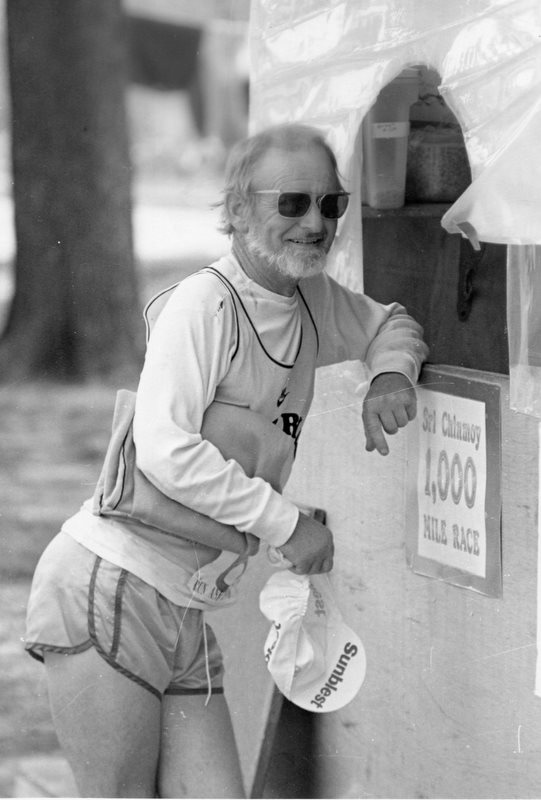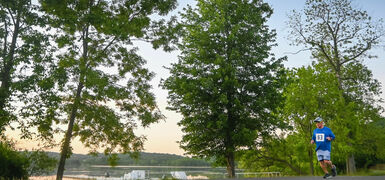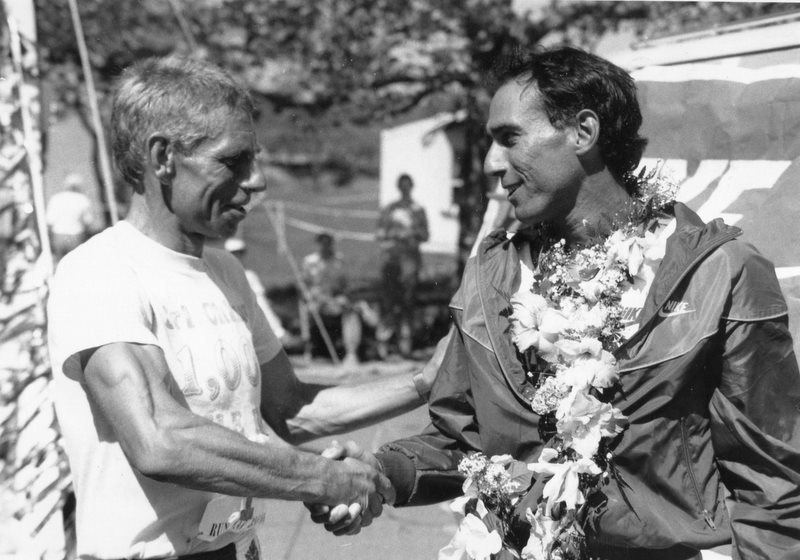Originally appeared in the July-August 1986 issue of UltraRunning. Reprinted by permission from Publisher, John Medinger
 The Sri Chinmoy Marathon Team created a long ultra that had everything: a world record lowered by 16 hours; a level of competition that was exciting at every level; and a support effort that no other organization in the world could have provided for 15 days of running in the middle of New York City. The race opened in a light drizzle with the cherry trees in a full bloom, and continued through a time change and a change of season as the trees were green by the race's end.
The Sri Chinmoy Marathon Team created a long ultra that had everything: a world record lowered by 16 hours; a level of competition that was exciting at every level; and a support effort that no other organization in the world could have provided for 15 days of running in the middle of New York City. The race opened in a light drizzle with the cherry trees in a full bloom, and continued through a time change and a change of season as the trees were green by the race's end.
Photo:Only a few miles separated Bauer (l) and Mittleman (r) during the first 7 days of the 1986 Sri Chinmoy 1,000 Mile Road Race.
The course was the familiar one-mile loop out-and-back; certified). It was modified slightly from the inaugural 1,000 mile in 1985 so that the course could be completely barricaded to separate the thousands of park users from the 13 competitors. The new arrangement worked like a dream. Although two of the three weekends had the kind of weather that brings thousands into New York City parks, the Sri Chinmoy marshals not only kept the course open at all times, but practiced an infectious courtesy and respect for the onlookers that tames the difficult New York public. The atmosphere surrounding the event was a large part of the experience. It was impossible to become grumpy or discouraged for any length of time. At every corner of the course, at every hour, day or night, there was always a friendly and encouraging word. It was a wonderful antidote to the "bad patches" that inevitably overtake us on every long runs. The Sri Chinmoy support did not eliminate what is probably a very sensible reaction of the body, but they could bring one out of a bad patch in record time.
 Physical therapy, massage, kinesiology, and blister treatment were available in warm medical areas. I was never necessary to go more than a few steps for any needed support, always given with encouragement and great understanding of the runner's needs.
Physical therapy, massage, kinesiology, and blister treatment were available in warm medical areas. I was never necessary to go more than a few steps for any needed support, always given with encouragement and great understanding of the runner's needs.
Photo: Members of the Sri Chinmoy Marathon Team man the scoreboard at night during the race.
A better competition could not have been organized. Siegfried Bauer was ready not only to defend his outstanding world record, but also to lower it by all he could. Don Choi meant to defend his American record and his win of 1985. Stu Mittleman, always fit and ready to compete at the highest level, had outdone himself with high mileage during the previous months. The English contingent of Alan Fairbrother and Dan Coffey would be tough competitors, and Trishul Cherns would be ready to move on the leaders by spending a lot of time on the course.
The first few hours saw Don Choi take off like a shot; he was determined to lead for as long as possible. Bauer, Fairbrother, and Mittleman went out fast too, but after 10 miles a log of sensible backing-off occurred. Perhaps the figure "10" was a sobering reminder of the number of zeros to be added to a mile at a time.
By the end of the first day Bauer led with 120 miles; Mittleman had 116 and Choi 111.
The second 24 hours was the second most interesting day of the race. Bauer with 95 miles and 215 for 48 hours, served notice that he was seriously after his mark of 12 1/2 days. Choi and Fairbrother stayed close at 188 and 185 miles for 48 hours. Mittleman, with no signs of distress and running steadily, had only the sixth-best second day at 66 miles, and dropped to fourth place.
On day three Fairbrother began having problems with shin inflammation and slowly dropped from the leaders. He tried to stick with it, running 4 consecutive 65-mile days followed by 75 and 80, but it all caught up with him on day ten. He ended up with a British best of 13 days and 22:48:08.
The fifth day was the beginning of the finest ultramarathon by an American since George Littlewood in 1888. Stu Mittleman's charge from 4th place to 2nd with 88 miles wasn't all that exciting at the time. Most of us were far more conscious of Bauer's 25-mile lead and his progress toward a new world record. Yet Stu's day was the first of the best six-day performance of the race.
At the end of the first six days Bauer led Stu 513 to 503. but Stu's 5th through 10th days added up to 530 miles. Looked at another way, Stu warmed up with 327 in the first four days and then turned a 530-mile six-day. At the end of that stint he was 38 miles in the lead. He ended up a full day ahead after 1,000 miles, lowering Bauer's record by 16 hours.
Stu did it by establishing a marvelous pattern of steady running. He walked occasionally, rarely for as long as an hour, and he wasted virtually no time. He was down for rests of 4 hours at about the same time each night. During the other 20 hours he was nearly always making forward progress, usually in excellent running form.
It is a tribute to Bauer's great competitiveness that he was not finished racing when passed by Stu in the last hours of day 7. Though Stu's lead was built to the 30-mile range through the 8th night, Siggy ran steadily on, staying within 30-odd miles through the 8th, 9th and 10th days. The 9th and 10th days saw both men with 80+ mileage, a wonderful display as they approached 800 miles of running. During this period it seemed that Siggy was working harder and that Stu was more worried. But both hammered out mile after mile until the 11th night when Stu's relentless pace finally sat Bauer down for a short extra meal in the middle of the night. Just before, Stu had been forced to walk for most of several hours, but he was able to walk at 15-17 minute page compared to Bauer's 16 minute running pace. Bauer stayed in the chase, but after a final effort to close the gap he took an afternoon off, and the race was finally over.
Mittleman and Bauer have made 80 and 90 miles a day commonplace, and they are probably the forerunners to a 10x100 mile performance.
Trishul Cherns, whose lack of sleep caught up with him last year, made adjustments, rationing sleep perfectly. He slept about 2 hours out of every 12, and finished two days sooner than in '85. Trishul and Colin Dixon of England are the world masters in the art of getting maximum performance from minimum rest. Their approach forces other runners to reevaluate what they think is the minimum amount of rest they must have.
 Dan Coffey had crashed in the David Niven 1,000 mile at Gateshead, England, last year, and he too rationed sleep successfully to finish well under the 15 day limit.
Dan Coffey had crashed in the David Niven 1,000 mile at Gateshead, England, last year, and he too rationed sleep successfully to finish well under the 15 day limit.
Photo: Dan Coffey enjoys a short rest during the race.
The five runners who finished were special, and they were placed atop the wonderful flower-bedecked float on which we all rode during the extraordinary closing ceremonies. But there were many noteworthy stories among the other entrants. Joe Michaels, who had double bypass heart surgery in 1980, covered twice his previous longest distance, completing 624 miles. His efforts continue to provide incentive for heart patients to achieve fitness and overcome their "disability." Sulochana Kallai, who started the race with modest goal of maintaining 35 miles a day, sand and smiled her way around the course for 12 days before dropping below that figure. Willie Rios, 69, made 806 miles. His performance will give statistician Andy Milroy a field day, as Willy established world age bests for any number of mile and kilometer marks.
The festival that was the awards ceremony included a ride around the course on a float as each competitor was honored by his or her own song composed by Sri Chinmoy and sung joyfully by his several hundred disciples gathered at the race. There were lots of gifts and food for everyone, even for the runners' mothers as the race ended on Mother's Day. The celebrations capped a moving experience for all of us who had enjoyed this special 15 days.
Marvin Skagerberg (700 mi)





 Shattering the previous world mark by 16 hours, New York's Stu Mittleman, 34, bested former record holder Siegfried Bauer of New Zealand, who finished runnerup. Mittleman ran the distance in 11 days 20:37. Bauer, age 44, ran ten hours over his 1983 record, clocking 12 hours, 22 minutes and 36 seconds.
Shattering the previous world mark by 16 hours, New York's Stu Mittleman, 34, bested former record holder Siegfried Bauer of New Zealand, who finished runnerup. Mittleman ran the distance in 11 days 20:37. Bauer, age 44, ran ten hours over his 1983 record, clocking 12 hours, 22 minutes and 36 seconds. Canadian Trishul Cherns, 29, lowered his own national record by more than two days, running 13+7:51 to finish third over Britain's Alan Fairbrother, 49, and Dan Coffey, 54. Both Englishmen set new national marks; Fairbrother first with 13+22:49, Coffey following with 14+10:45.
Canadian Trishul Cherns, 29, lowered his own national record by more than two days, running 13+7:51 to finish third over Britain's Alan Fairbrother, 49, and Dan Coffey, 54. Both Englishmen set new national marks; Fairbrother first with 13+22:49, Coffey following with 14+10:45.






 The record for the straight-forward 1,000 miles remained with
The record for the straight-forward 1,000 miles remained with






